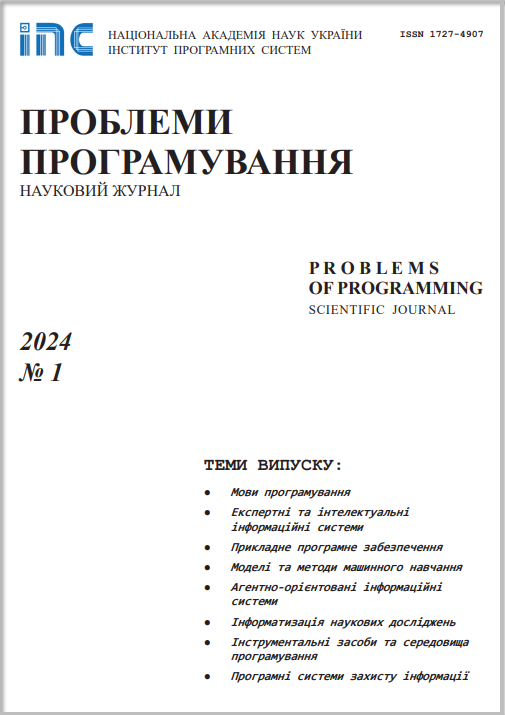Recognition of emotional expressions using the grouping crowdings of characteristic mimic states
Abstract
Problems in programming 2020; 2-3: 173-181
Keywords
Full Text:
PDF (Українська)References
Hjortsjö C.H. Man's Face and Mimic Language, Studentlitteratur. Lund, Sweden, 1970.
Ekman P., Friesen W.V. Manual for the Facial Action Code. Palo Alto, CA: Consulting Psychologist Press. 1978.
Ekman P., Friesen W.V., Hager J.C. The Facial Action Coding System. Salt Lake City, UT Research Nexus eBook. 2002.
Hamm J., Kohler C.G., Gur R.C., Verma R. Automated Facial Action Coding System for dynamic analysis of facial expressions in neuropsychiatric disorders. Journal of Neuroscience Methods. Philadelphia, USA. 2011.
Brunelli R., Poggio T. Face recognition: features versus templates. IEEE Transactions on Pattern Analysis and Machine Intelligence. 1993. 15(10). P. 1042–1052.
Kryvonos I.G., Krak I.V. Modeling human hand movements, facial expressions, and articulation to synthesize and visualize gesture information. Cybernetics and Systems Analysis. 2011. 47. P. 501–505.
Krak Yu.V., Barmak A.V., Baraban E.M. Usage of NURBS-approximation for construction of spatial model of human face. Journal of Automation and Information Sciences. 2011. Vol. 43(2). P. 71–81.
Martinez A., Du S. A model of perception of facial expressions of emotion by human: research overview and perspectives. Journal of Machine Learning Research. 2012. 13. P. 1589–1608.
Kryvonos I.G., Krak I.V., Barmak O.V., Ternov A.S., Kuznetsov V.O. Information Technology for the Analysis of Mimic Expressions of Human Emotional States. Cybernetics and Systems Analysis. 2015. 51. P. 25–33.
Barmak O.V., Kalyta O.D., Hashchuk T.O. Skrypnyk T.K. Information technology for determining the criteria of facial areas that reproduce emotional facial expressions. Herald of Khmelnytskyi national university. Technical Sciences, Issue 6, 2018 (2). p. 130-134.
Barmak A.V., Krak Y.V., Manziuk E.A., Kasianiuk V.S. Information technologyof separating hyperplanes synthesis for linear classifiers. Journal of Automation and Information Sciences. 2019. 51(5). P. 54–64.
Krak I., Barmak O., Manziuk E. Using visual analytics to develop human and machine centric models: A review of approaches and proposed information technology. Computational Intelligence. 2020. 1– 26. CrossRef
Cox T.F., Cox M.A.A. Multidimensional scaling, 2nd edn. Chapman and Hall / CRC, Boca Raton, 2001.
Krak I.V., Kudin G.I., Kulyas A.I. Multidimensional Scaling by Means of Pseudoinverse Operations. Cybernetics and Systems Analysis. 2019. 55(1). P. 22–29.
Barmak A.V., Krak Yu.V., Manziuk E.A., Kasianiuk V.S. Definition of information core for documents classification. Journal of Automation and Information Sciences. 2018. Vol. 50(4). P. 25–34.
Maaten van der L.J.P., Postma E.O., Herik van den H.J. Dimensionality reduction: a comparative review. Technical report TiCC-TR 2009-005. Tilburg University 2009.
Leeuw de J., Mair P. Multidimensional scaling using majorization: SMACOF in R. Journal of Statistical Software. 2009. Vol. 31. Issue 3.
P. 1–30.
Wingenbach TSH, Ashwin C, Brosnan M Correction: Validation of the Amsterdam Dynamic Facial Expression Set – Bath Intensity Variations (ADFES-BIV): A Set of Videos Expressing Low, Intermediate, and High Intensity Emotions. PLOS ONE 11(12): e0168891. 2016. CrossRef
DOI: https://doi.org/10.15407/pp2020.02-03.173
Refbacks
- There are currently no refbacks.


